Juror: Dr. Sarah Clark-Langager
Curator: Hank T. Foreman
Assistant Curator: Brook Bower
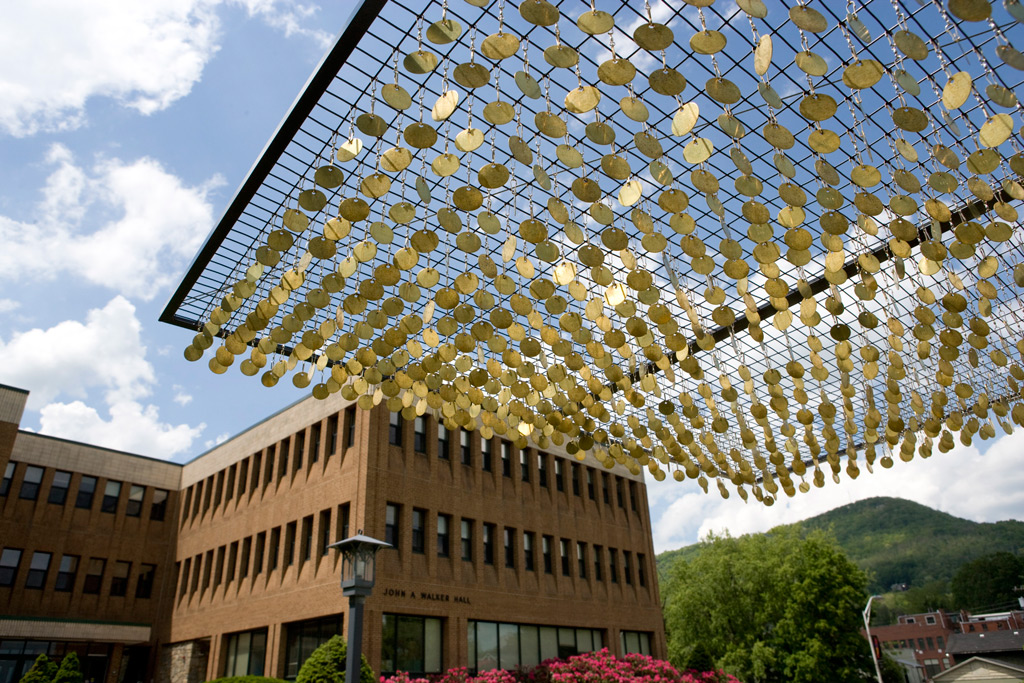
Shawn Skabelund, Brassing Out: Site Specific Work. 2008 / 22nd Rosen Sculpture Competition Winner.
Sculptures
-
Brassing Out: Site-Specific Work1st Place
Brassing Out: Site-Specific Work
Shawn Skabelund
Flagstaff, Arizona
Steel, wood, brass and pinesap
7.5′ x 8′ x 4′
Site specific
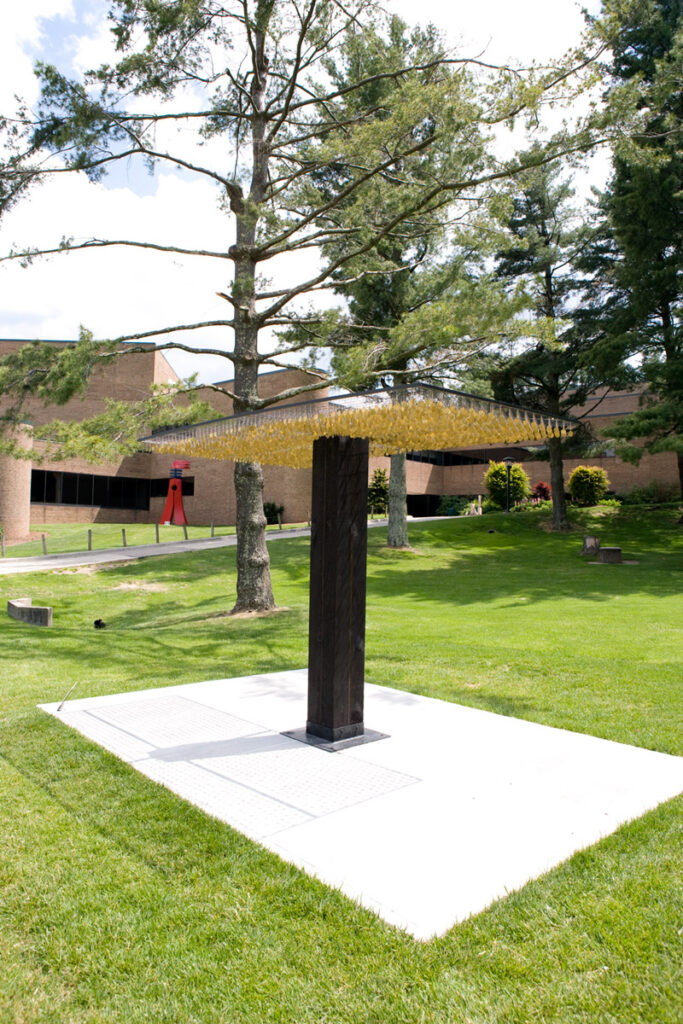
Artist statement
My work explores what Wendell Berry calls the “unsettling of America,” namely, the effects, the marks, and the changes that humans make on the land and cultures of a given area. To prepare for each piece, I research the history of the place to learn what has determined the cultural makeup of the community. This “collaborating with a place” helps me understand what I want to share with my audience.
I live in Arizona, a state founded on the mining of copper ore—malachite and azurite. Since it is part of the Appalachia, I knew that coal mining was important in North Carolina. But little did I know the role that the minerals—feldspar, quartz, and mica—mined in the “tar heel” state have played and continue to play in the economy of the state and the nation.
On the morning of May 27, 1925, three explosions rocked the Egypt Coal Mine in Farmville. This became the state’s worst mining accident. 53 men did not “brass in” that day.
This sculpture recalls that accident and the hundreds, perhaps thousands, of other deaths in the Appalachia caused by “burrowing into the earth”.
Before heading down the shafts and into the stopes, miners were given numbered brass tags. When their shift was complete, they would return their tags to the brassing-in board, signifying that they had made it out of the ground for another day. I titled this sculpture Brassing Out because each day represented an act of faith for these miners.
About the artist
The son of a U.S. Forest Service hydrologist, and homemaker, I was born in Mt. Pleasant, Utah and grew up in a variety of small communities in the west, the most memorable being the small logging town of McCall (Idaho). My fondest childhood memories center on the days I spent huckleberry picking in the mountains. I attended Utah State University, graduating in 1987 with a BFA in Drawing. That same year, I also received the University’s Robins Award for Achievement of the Year, and an anonymous gift of $500 to further my education in art. To this end, I attended graduate school at the University of Iowa, and earned both a MA (1989) and a MFA (1990) in Drawing/Painting. In 1991, I married Alexandra Carpino, an art historian who specializes in the field of Etruscan art. Our son, Adrian, was born in 1996 and our daughter, Chiara Rose, in 1999. Currently, I teach courses in Drawing, Figure Drawing and Installation art in the School of Art at Northern Arizona University.
Since 1993, I have maintained an active exhibition schedule, showing drawings, sculptures, and numerous large-scale, site-specific, place-based installations at venues throughout the U.S., many which were part of one-person shows. In 1998, I had a retrospective of my work at Wayne State University; the show included drawings from graduate school, recent sculptures, and three large-scale installations, including A Toll on Earth, which was reviewed in the 1999 Jan./Feb. issue of Sculpture.
I have been recognized by arts organizations in Alaska, Arizona, Iowa, Michigan and Ohio. My awards include a 1996 Creative Artists Grant from the Michigan Council for the Arts for A Path that Joins, and Divides; the 1999 William & Dorothy Yeck Award for Temple of the Sibyl; and a 2003 Artist Project Grant from the Arizona Commission on the Arts for Virga (The Hunt for Water). And in 2004, I became the first Flagstaff artist to receive a grant from the Phoenix Art Museum’s Contemporary Forum.
For more information, visit www.shawnskabelund.com.
Curator’s Comments
WHAT IS THE SITE-SPECIFIC CATEGORY?
This category is dedicated to the creation of a Site-Specific work of art. Site-specific refers to a work of art specifically designed for a particular location while creating an interrelationship with the location. Site-Specific artists are required to submit a selection of images of works that have been previously created by the artist that are indicative of the artist’s style and exhibits the ability to create an effective site-specific work.
Hank T. Foreman
Council Columns
Glenn Zweygardt
Alfred Station, New York
Steel, stainless steel, cast glass, bronze and enameled steel
10′ x 8′ x 8′
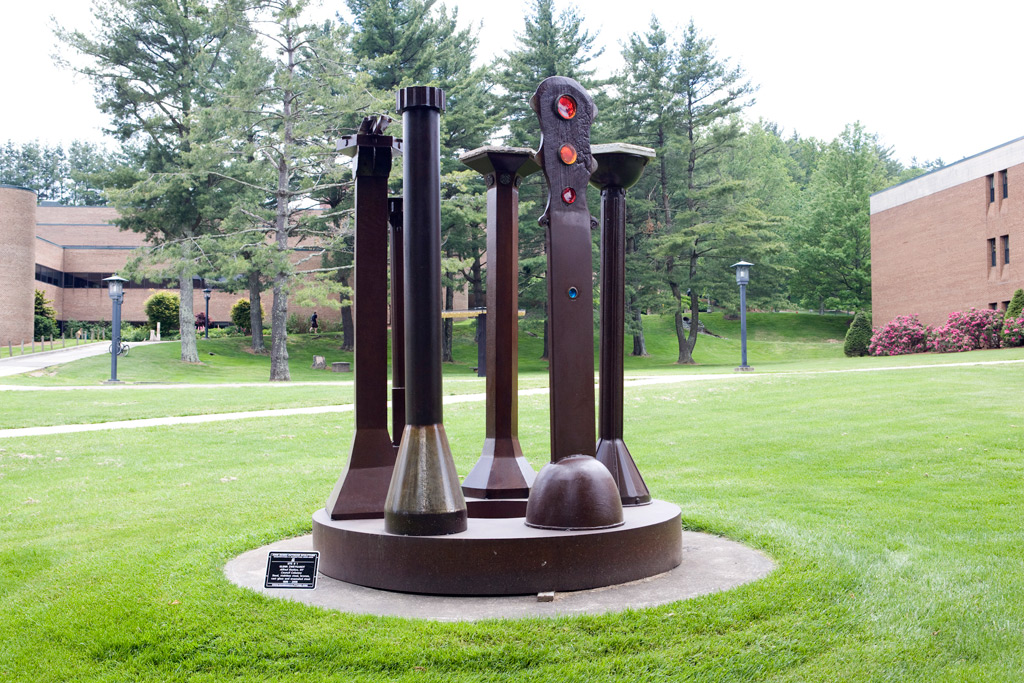
Artist statement
COUNCIL COLUMNS has been in process for a long time. I started the columns in the 1990’s and could not find the appropriate conclusion to them until I developed the large plinth or base element. This final element gave the proper conclusion, as the council was now convened and evident. I enjoy how I can give personality or human traits to materials like steel, iron, stone, and glass. Humans have been doing this for a long time!
About the artist
Born and raised in northwest Kansas, Glenn Zweygardt received his BFA from Wichita State University in sculpture and painting. He then earned his MFA from the Rinehart School of Sculpture at Maryland Institute College of Art in Baltimore, Maryland.
For over 40 years, Glenn has been an active sculptor and educator. With more than 50 solo exhibitions and multiple purchase awards to his name, he shows works both nationally and internationally. His sculptures are included in many university, museum, outdoor and private collections.
Now an emeritus Professor of Sculpture at the New York State College of Ceramics at Alfred University, Glenn continues to make signature sculptures in his Alfred Station studio. His creations of steel, ductile iron, stainless steel, cast glass, cast bronze and aluminum are often combined with stone from around the world. These sculptures range from monumental outdoor works to small, intimate pieces.
For more information, visit www.glennzweygardt.com.
Earth, Fire and Wind
Hannah Jubran
Grimesland, North Carolina
Painted steel
14′ x 6′ x 3′
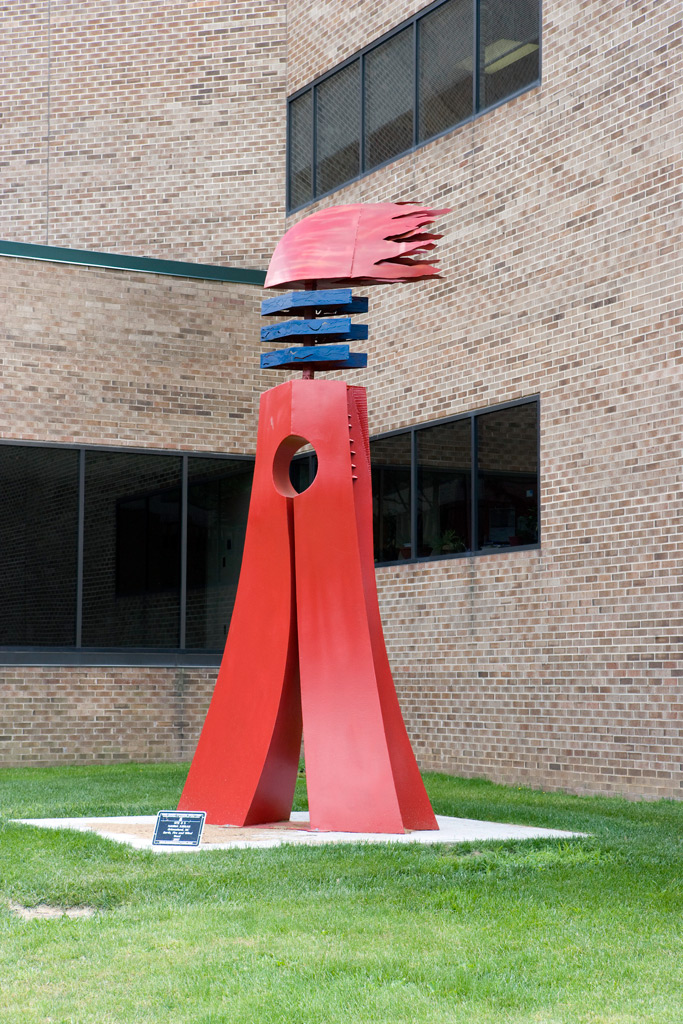
Artist statement
This sculpture is from a series of work that deals with the concept of the four elements, Earth, Water, Fire and Wind in our universe on the micro and the macro level. It expresses the cycle of life, growth and continuum. The interplay of shape, form, space and colors. These four elements are seen in a variety of forms shapes and colors as they occur in nature. They are ever changing. As Gibran Kalil Gibran said, “ The mission of art is to bring out the unfamiliar to the most familiar.” With this, I would like the viewer to gaze, interact and experience my sculpture.
About the artist
Hanna Jubran received his Master of Fine Arts degree in sculpture from the University of Wisonsin-Milwaukee in 1983, and he currently a Sculpture Professor at East Carolina University in Greenville, NC. Since 1996, he has participated in over 278 exhibitions, international symposia, national and international conferences, and over 50 lectures and workshops. His recent activities include a commission entitled “A Monument to a Century of Flight” in Kitty Hawk, NC. For every symposium Hanna has participated in, his sculpture has been kept as part of that town’s or organization’s permanent collection.
For more information, visit www.hannajubran.com.
Getting Back on the Totem
Sharon Collings Licata
Columbia, SC
Limestone
4’6″ x 3′ x 3′
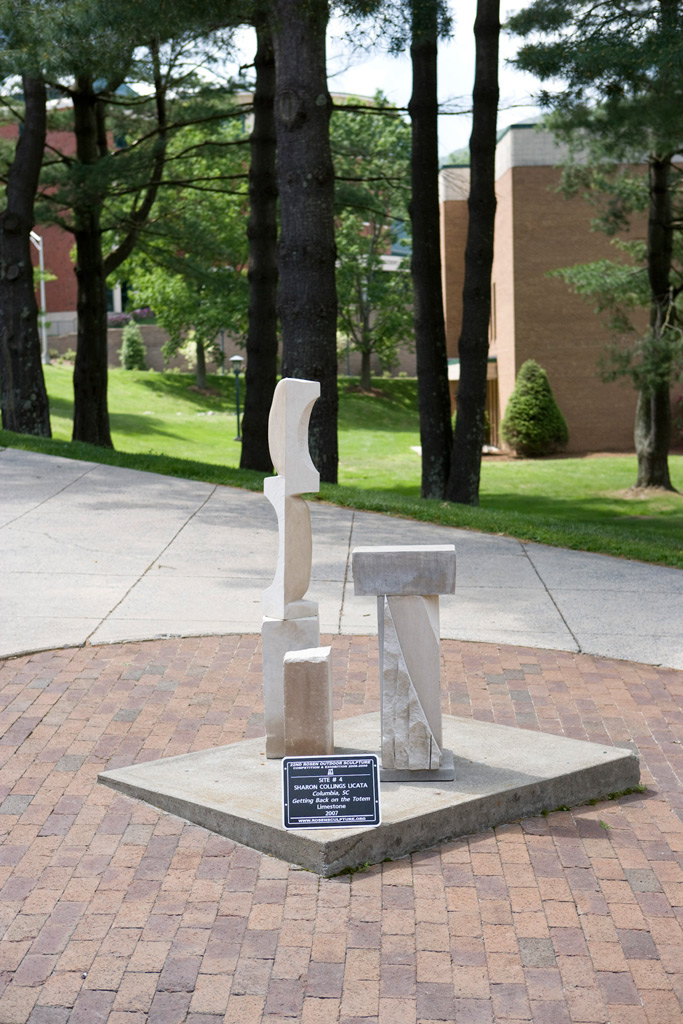
Artist statement
To me Art is a verb.
I always find myself returning to a sense of motion in my art. It is important that it be viewed from all sides. Only then can one get a sense of all the interactions of space and line that came into play during creation.
No matter what medium, realistic or abstract subject matter, my art has at it’s heart, motion; the curves and twists of searching and of reaching upward.
About the artist
Sharon is a graduate of Agnes Scott College with a B.A. in Art and Political Science, and USC with a Masters of Media Arts. A sculptor of both realistic and abstract form, Sharon works in a variety of media: stone, clay, and formed stone. Her sculptures are in numerous private and corporate collections as she has shown in many parts of the country. When not in the studio, she can usually be found teaching statewide as a “Visiting Artist” for the SC Arts Commission.
For more information, visit www.gallery80808vistastudios.com.
Maya II
Jon Mehlferber
Clarkesville, Georgia
Concrete
11′ x 11′ x 2′
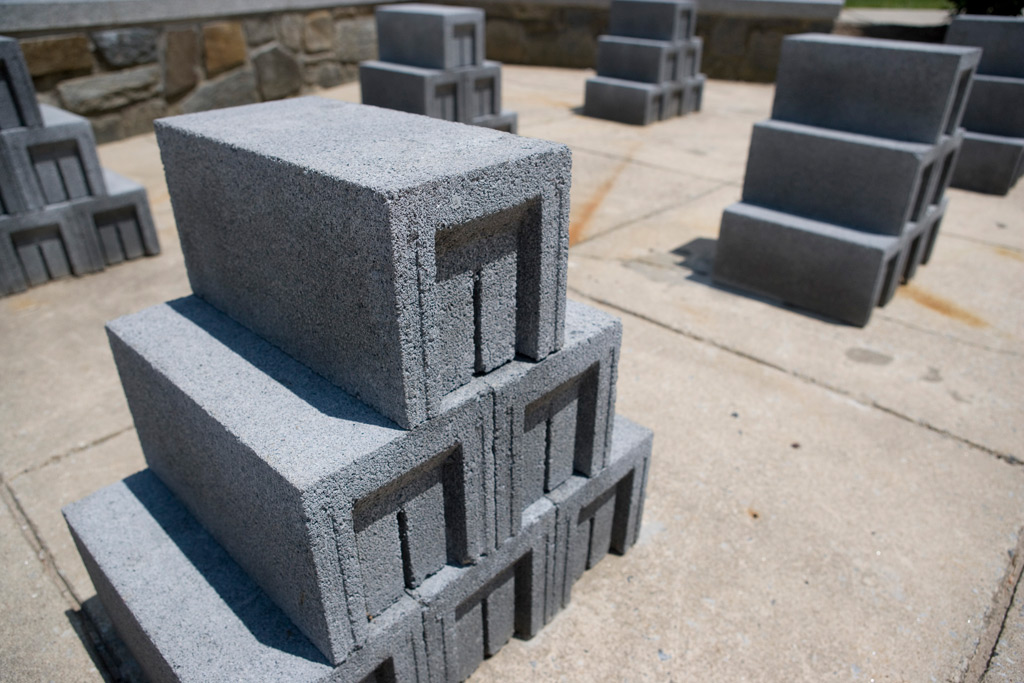
Artist statement
Sculpture in the form of a dwelling or “house” has some ten thousand years or more of tradition. Human beings tend to use the dwelling symbolically, as an expression of their desire to create a realm of order within the chaos of the world. The dwelling is also a cosmological image or imago mundi. Thus, structural features and activities associated with the dwelling relate it to the paradigmatic creation of the gods, the cosmogony.
Carl Jung’s concepts of the collective unconscious and the archetype account for the almost universal occurrence and symbolic significance of the dwelling. All the various representations of the dwelling motif are “archetypal symbols”—symbols of the archetypes corresponding to the need for spatial order and protective shelter, which Jung calls the “mother” and the “self.” In Jung’s thought, the mother archetype is associated not only with the “good” qualities of protection, nurturing, and growth, but also with “evil” qualities, like secrecy, darkness, and suffocation (overprotection). The archetype of the self is the archetype of order and wholeness.
In this context, the arrangement of concrete blocks that make up this work are not neutral geometric shapes, but protective containers, just as the walls of a house are protective or exclusive boundaries. Their ordered stacking also gives them a sense of being both monumental and ceremonial—like Mayan stepped pyramids. These pyramids were used both as platforms for important temples—presumably as the place closest to the heavens—and also as tombs.
About the artist
Jon Mehlferber is the youngest of six children, born in Homestead, Pennsylvania. After earning a BFA in sculpture from the University of Central Florida in Orlando in 1986, he relocated to Athens, Georgia. where he pursued a MFA in sculpture and a PhD in the Theory and Criticism of Art. Always an active artist and educator, Mehlferber’s work has been featured in over 100 exhibitions since 1984. He currently resides in Clarkesville, Ga. with his wife, Jami, and their children, Elijah and Linden. Mehlferber is an Assistant Professor of Art at North Georgia College & State University in Dahlonega, GA.
Mute
Duke Oursler
Statesboro, Georgia
Steel
5’6″ x 4′ x 4′
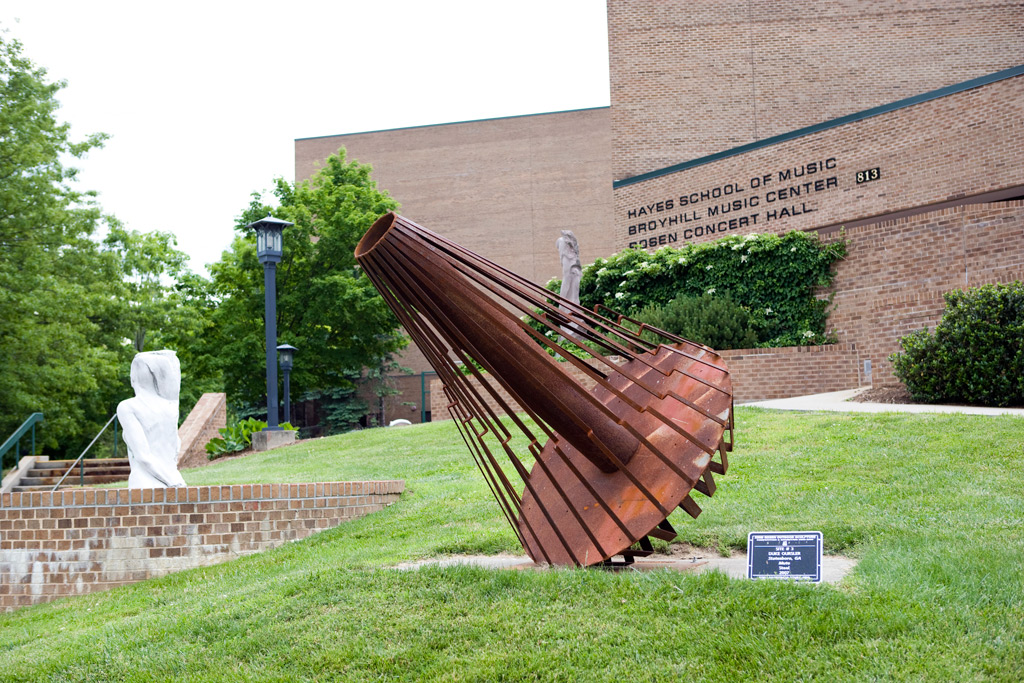
Artist statement
My work is a direct response to an event, issue, idea, place or situation. I like to work directly from my intuition to create sculpture on a large-scale that satisfy me visually and appeal to me physically. I want to effect and organize space with my sculpture. I greatly enjoy the process of making a new piece, and the personality that the piece develops throug out the process. At the completion of a work, I have a period of rediscovery and always find some new way that the piece works for me.
During the process, most of the decisions I make are completely intuitive. I try to let the work create its own aesthetic and evolve in a natural and free way. I find that working in steel allows me to explore planes, curves, and patterns in a large space. This enables me to relate to my work in a physical way that I find very engaging.
My work has been evolving. Themes of segmentation and movement have become apparent to me. The repetition of shape and the spaces that I can create with these patterns have become valuable. Utilizing the versatility of steel I am able to explore the way forms and patterns come together and play off on another.
About the artist
Duke Oursler was born on the plains of western Kansas. He received his BFA from the University of Northern Iowa in 2007. He is a MFA candidate at Georgia Southern University. His work has been exhibited in Kansas, Georgia, Iowa, North and South Carolina. He currently resides in Statesboro, Georgia. Duke’s work often shows themes of movement and rhythm. He employs various materials such as steel, wood, stainless steel, bronze and stone.
Repeating Ourselves to the Stars
Peter Frantz
Tyrone, Pennsylvania
Root, steel and video
7’8″ x 4′ x 3′
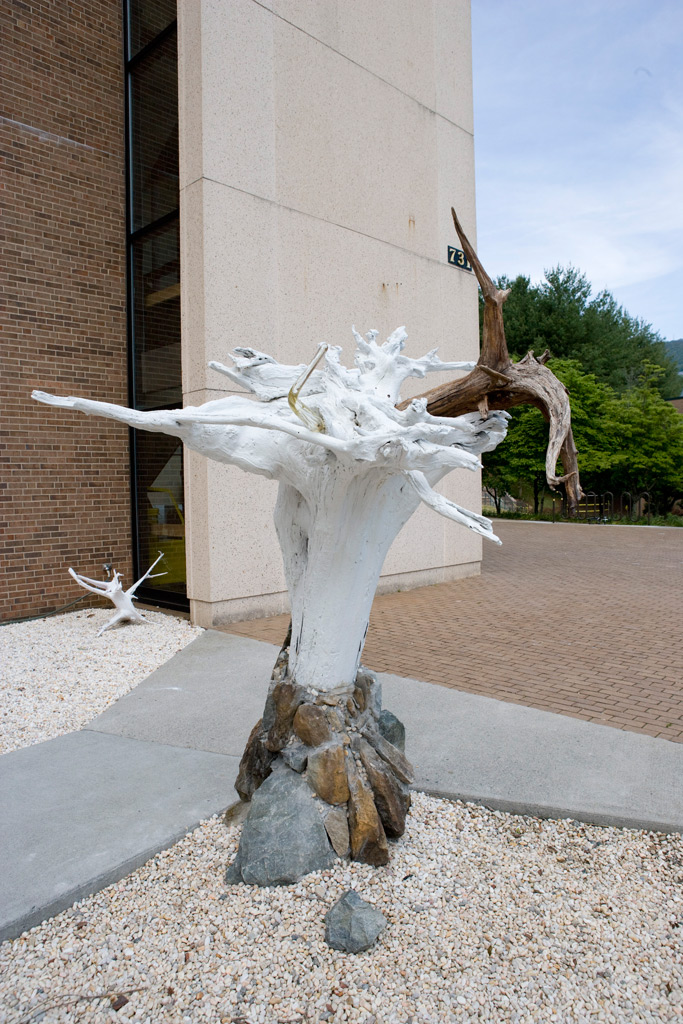
Artist statement
Time as it is so often described may exist or it may not, but there are breaks in the continuum; it is the cadence. The interval can be fast (atoms disintegrating) or slow (the birth and death of stars), but interval it is. Life as we know it is pandemonium based on the unceasing modulation of the cosmic plane. This is why rhythm is so basic to our psyche. We live by it; the tick tock of cadenza is how we repeat ourselves to the stars.
We are millions of souls creating our own beat, like intertwining and never-ending fractals writing against the score of the sky. It is throwing stone after stone skipping across a pond, the prayer wheels of Tibet and the drums of Africa. It is the allegory for the rhythm that is created by humans to match the heartbeat of the cosmos.
About the artist
Peter Frantz is a third generation artist, born in Tyrone, Pennsylvania. He attended the University of Notre Dame, Goddard College and attained his Master of Fine Arts degree from the Pennsylvania Academy of the Fine Arts in 2007.
He is a sculptor, installation artist and printmaker who emphasizes the use of multiple ordinary materials, such as glass and cast bronze, in combination with video, light and sound to stress the use of art as means of conversation and community.
Much of his work uses the arch or the elliptical forms as a metaphor for continuity across spatial and emotional distances. Frantz explores the non-traditional and non-fixed relationships the sculptures create between viewers who are not in proximity to each other.
In the late 90’s and early 2000’s, Frantz worked with wood, steel and other mixed materials, whose “content” was their suspension of belief, or the inclusion of uncertainty.
His most recent solo exhibition was held from May through August 2007 at the Southern Alleghenies Museum of Art.
For more information, visit www.peterfrantz.com.
Tree and Sky
Cathrin Hoskinson
Brooklyn, New York
Aluminum cut and painted
8′ x 1’6″ x 2′
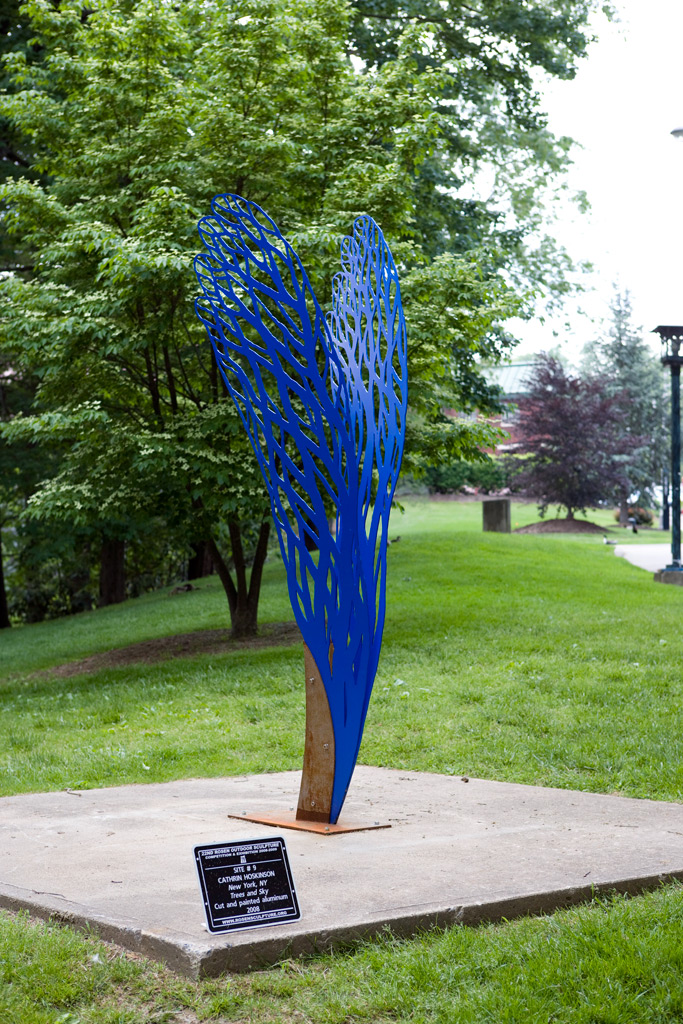
Artist statement
“Trees and sky” could as easily be titled Veins and branches, Hands and leaves, Shadow and wind.I think of the sculpture as a poem, which exists at the intersection of several lines of thought. It is the color of the summer evening sky, when trees become silhouettes. The drawing is a linear pattern of the nervous system, branches, or wings. It touches the ground like a thorn or dancer, and is made of a thin industrial material, cut and ground into an organic form. The overlay of metaphors becomes an idea of the self in its surroundings.
My work often combines the experience of landscape with its memory in the body, either as a parallel structure or emotional place. I have based abstracted forms on birds, insects, seeds, and effects of water, and combined ideas about the essence of natural forces with parts of the body or gesture. The work is thought about while wandering through the forest with my dog, and develops through the life of the studio. In tracing similarities of inside and outside, I feel I am deciphering a code about being in the world.
About the artist
Cathrin Hoskinson received her MFA from Hunter College in New York and also studied at Concordia University in Montreal and SUNY Purchase. Originally a native of Vancouver, Canada, she now divides her time between the countryside of Accord, NY and Lower Manhattan. She worked for many years as a wax technician and mold maker at Argos Foundry in Brewster, where she was able to develop practical skills in metal work.Her sculpture, paintings and drawings have been exhibited in many locations around New York, including the Neuberger Museum, The Studio in Armonk, the Katonah Museum and the Drawing Center.
For more information, visit www.cathrinhoskinson.com.
Tubular Text
Bill Vielehr
Boulder, Colorado
Cast and prefabricated manganese bronze and stainless steel
8′ x 1’3″ x 1’3″
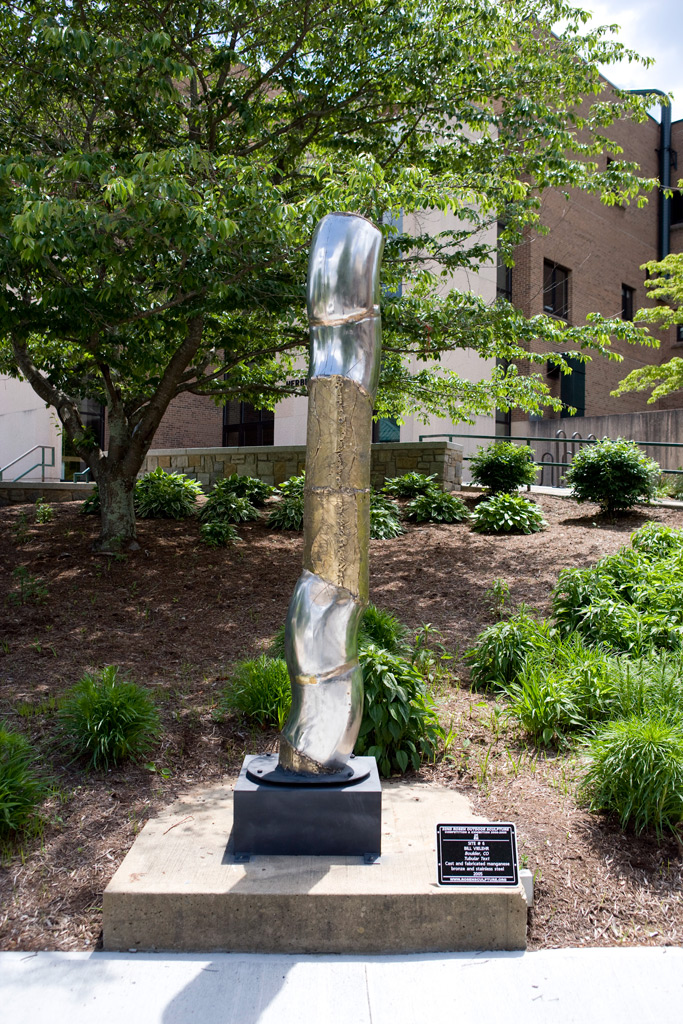
Artist statement
My work is universal in nature and visually able to stand the test of time. Reflection, high polish and color are inherent to the process that creates my reliefs and freestanding bronze and aluminum walls and columns. The sculptures change colors through the day and the seasons through undulating chrome-like reflective surfaces that mimic sunsets, sunrises, blue skies, city lights and colors from all passing entities, creating transforming visual patterns. Visual art references etched in the metal and addressed in the finishing of the works make them ideal for a public art environment.
The work I am involved with at this point is people friendly and inviting, usually free-standing walls or wall works, full of sculptural elements and sometimes incorporating seating. The sculptures are designed to draw people to them—to walk around and touch them—delighting each viewer with the variety of texture, color, form, and discovery of theme. My work is very tactile and intensely visual because of the use of lines and texture contrasting with the highly polished surfaces.
The sculptures are highly durable, low-maintenance, cast and fabricated bronze and aluminum. The method is to create drawings and sketches (symbols) that are sculpted and textured in wax, and then cast. The symbols used are part of the communication message and enhance the cultural relevance and humanize the work.
Many site-specific works seem to be caught in time, to be particular to the present. I prefer to pursue a timeless quality in my work, a breach of culture, time, and technique that transcends the immediacy. The perception of now can appear shallow, and the depth of tomorrow and yesterday can be emphasized. I attempt to use contemporary and historic effects together to make the work timeless and ageless—prompting us to relate forward and backward simultaneously.
About the artist
Bill Vielehr, a Boulder native, graduated from Colorado State University with a BFA in 1969, and did graduate work the same year (Special Studies of Sculpture). His career in sculpture spans more than three decades, during which time he has been commissioned to create many private, municipal and corporate works that have garnered both artistic and public approval. His work has been represented by galleries in Chicago, Santa Fe, Taos, Boulder, Denver, San Francisco and Berkeley. Bill participates in many annual public art exhibits, and some of his awards include “Best of Show” Art on the Commons, Lakewood CO (2002); “Best of Show” Firehouse 3D Show, Longmont CO (2000); and the “Lou Wille Award for Excellence” Art on the Corner, Grand Junction CO (2000). In addition to being a full-time sculptor, Bill’s art-related endeavors include being a curator, college instructor, featured speaker, Director of FORM Sculpture and guest lecturer. In the summer and fall you can find Bill river-running, getting inspiration for his markings from the rock walls towering above.
For more information, visit www.vielehr.com.
About the juror
Sarah Clark-Langager has been curator of the renowned Outdoor Sculpture Collection and director of the Western Gallery at WWU since 1988. Before coming to Western, she was involved on both coasts in educational and curatorial roles at such museums as Yale University Art Gallery (New Haven), Albright-Knox Art Gallery (Buffalo), Seattle Art Museum and Munson-Williams-Proctor Institute (Utica). Specializing in 20th century and contemporary art, she also acts as an advisor to may institutions initiating public art collections and policy.
The Western Gallery acts as a center for the display, discussion and exchange of ideas on critical issues in contemporary art from our region and from the national and international art scene. Exhibits, which offer a variety of artistic styles in many different mediums, change frequently.
About the curators
Hank Foreman
Hank Foreman serves as Assistant Vice Chancellor of Arts and Cultural Affairs as well as Director and Chief Curator of the Turchin Center for the Visual Arts for Appalachian State University. He obtained his M.A. in Art Education from Appalachian, having completed undergraduate studies at the University of North Carolina at Charlotte, with a concentration in Painting and Sculpture. His duties include the administrative responsibilities for An Appalachian Summer Festival, the Performing Arts Series, Farthing Auditorium and the Turchin Center for the Visual Arts.
During his tenure at Appalachian State, Foreman has taken part in the organization of numerous exhibitions, including the associated lectures, symposia, and publications. He has worked closely with the university’s Department of Art, and a wide variety of other campus and community groups, to make gallery resources available to all. One of his earliest exhibitions at Appalachian, Views From Ground Level: Art and Ecology in the Late Nineties, brought internationally acclaimed artists, historians, and critics to the campus and received national attention.
Foreman is also an exhibiting studio artist, and participates in regional and national conferences as a presenter and panelist.
Brook Bower
Brook Bower serves as the assistant curator and administrator for the Turchin Center for the Visual Arts and its staff. She received a BS in Art Management and a BFA in Ceramics from Appalachian State University’s Department of Art in 2001. Bower’s professional activities include curating exhibitions, lecturing, consulting for competition management, serving as a juror for local competitions, mentoring future art management students and managing several national art competitions including the Rosen Sculpture Competition, the Halpert Biennial and the Appalachian Mountain Photography Competition. Bower also serves as the Acting Registrar, providing collections management support for the Turchin Center’s Permanent Collection containing 1,481+ objects and managing the Intra-Campus Loan Program.
Following her undergraduate degrees, she has concentrated on furthering her education by attending conferences, courses and workshops expanding her knowledge of curatorship, exhibition design, and collections management. Bower recently participated in the 2011 SEMC Jekyll Island Management Institute and is currently seeking a Master of Visual Arts Administration, with a focus in curatorial studies, at New York University in New York City. She serves on multiple committees that concentrate on community enhancement utilizing the visual arts and serves as the faculty advisor for the Arts Management Organization (AMO). In addition, Bower is an active exhibiting artist.
